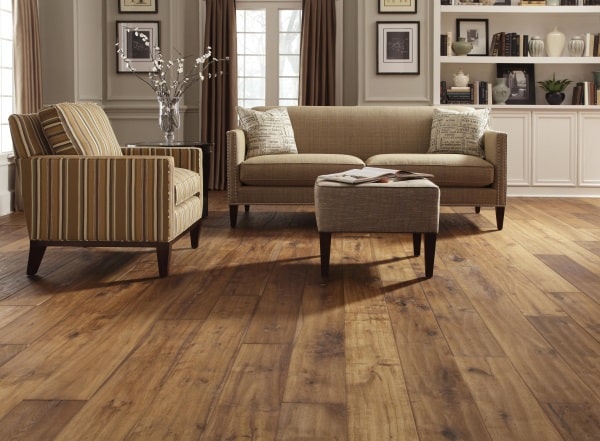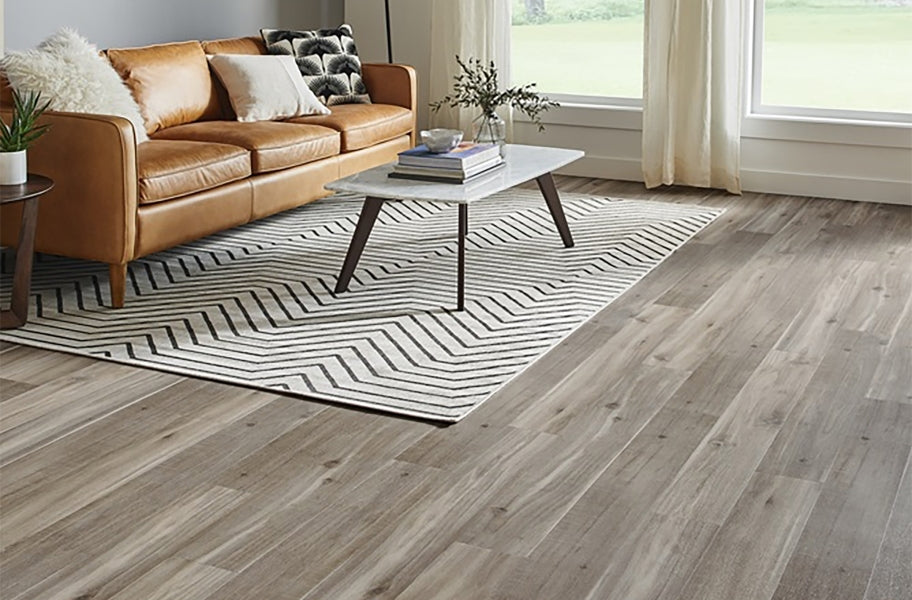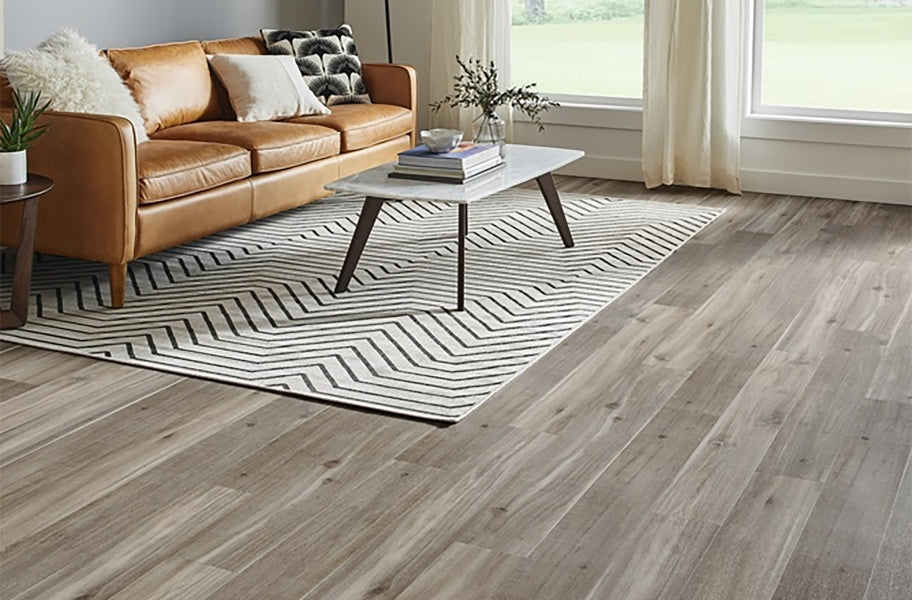Greetings, cherished floor lovers! Today, let's embark on an exciting journey into the realm of flooring innovation, as we unravel the enchanting attributes of WPC Vinyl flooring. Unveiling the Wonders of WPC Vinyl Flooring is ideal for those contemplating a flooring upgrade. Fasten your seatbelts as we explore why WPC Vinyl flooring is rapidly becoming the go-to choice for savvy homeowners.
editor note: WPC vinyl flooring has been around for many years. This article is topical because due to production innovations, we are seeing a surge in popularity for WPC vinyl flooring recently. It is possible that WPC Vinyl flooring will capture significantly more market share in North America in the near future.
What is WPC Vinyl Flooring?

WPC, an acronym for Wood Plastic Composite, forms the foundation of WPC Vinyl flooring – a groundbreaking solution marrying the timeless allure of wood with the resilience of plastic. This flooring variant falls under the luxury vinyl category, presenting an economically viable and visually captivating alternative to traditional hardwood or laminate flooring.
WPC vinyl, SPC Vinyl (stone plastic composite), and any other click lock flooring product that has a solid core are sometimes also referred to in a general catch-all term: Rigid Core Vinyl Flooring.
Rigid Core Vinyl Flooring, often referred to simply as rigid core or Rigid Core Luxury Vinyl Plank (LVP), is a high-performance flooring option that combines the best features of several flooring types. It is part of the broader category of Luxury Vinyl Plank (LVP) flooring, renowned for its realistic wood-look appearance and waterproof properties. What sets rigid core vinyl apart from its counterparts is the unique construction of its core layer.
Construction of Rigid Core Vinyl Flooring
At the heart of rigid core vinyl flooring lies its namesake – a rigid, dense core layer that forms the backbone of the entire structure. This core layer is typically made from a combination of limestone dust, polyvinyl chloride (PVC) resins, and other stabilizing materials. The result is a robust and dimensionally stable core that provides a solid foundation for the flooring.
Ok, back to our focus of the day, specifically WPC Vinyl flooring.
How is WPC Vinyl Flooring Made?
A comprehension of the intricate layers composing WPC Vinyl flooring unveils its distinctive characteristics. This innovative flooring marvel consists of four primary layers:
Wear Layer: Serving as the surface's protective shield, the wear layer ensures resistance against scratches, stains, and fading. This layer safeguards your flooring, preserving its aesthetic charm even in high-traffic zones.
Vinyl Decorative Layer: The second layer is where the magic unfolds. A high-resolution image of wood is intricately printed onto this layer, delivering an authentic semblance to hardwood flooring.
WPC Core Layer: The core layer forms the nucleus of WPC Vinyl flooring. A waterproof core, concocted from a blend of wood and plastic composites, not only contributes to structural stability but also shields the flooring from moisture. This characteristic renders WPC Vinyl flooring ideal for spaces prone to spills, such as kitchens and bathrooms.
Backing Layer: The bottom layer provides additional support and stability, completing the WPC Vinyl flooring structure with finesse.
WPC Core Layer: The Engine Room of WPC Vinyl Flooring

The WPC Core Layer, often hailed as the powerhouse of WPC Vinyl flooring, serves as the linchpin for its structural integrity and resilience. Contrary to what the name suggests, the composition of this core has evolved over time, reflecting a departure from traditional wood-based formulations.
Initially, WPC, standing for Wood Plastic Composite, indicated a blend of wood and plastic composites in the core layer. However, the current reality unveils a fascinating shift in the formulation. Many contemporary WPC Vinyl manufacturers have transitioned away from incorporating wood in their cores. Instead, they have embraced innovative materials such as stone powder, virgin plastics, and carefully selected additives to enhance stability and performance.
This strategic departure from traditional wood-based cores addresses a critical concern – the susceptibility of wood to moisture. By substituting wood with stone powder and virgin plastics, manufacturers have effectively mitigated the age-old issue of wood's unfavorable reaction to water. This transformation not only ensures the longevity of the flooring but also elevates its resistance to moisture, making it an ideal candidate for spaces prone to spills, like kitchens and bathrooms.
The formula modifications undertaken by manufacturers aren't merely for cosmetic reasons. The aim is to create a WPC core that is not only more stable but also less prone to expansion and contraction. This adaptability to environmental changes is pivotal, especially in regions where temperature and humidity fluctuations are prevalent.
As manufacturers continue to innovate and refine the formula of the WPC core, homeowners can enjoy the peace of mind that comes with a flooring solution that remains steadfast against the challenges of everyday life. The incorporation of stone powder and virgin plastics not only fortifies the core against moisture-related issues but also enhances its overall performance, making it a smart and durable choice for various living spaces.
In essence, the evolution of WPC Vinyl flooring's core composition highlights the industry's commitment to pushing boundaries and delivering flooring solutions that not only align with contemporary needs but also surpass traditional limitations. So, while the name may still carry the echo of wood, the reality is a sophisticated fusion of materials engineered to offer a robust, waterproof, and visually appealing flooring option for today's homeowners.
editor note: Yah, its weird that Wood Plastic Composite vinyl flooring may no longer have any wood. No wood?? What the? Remember I said its been around for a while? It has, and the WPC name has stuck. The production process is the same, the formula that goes into the core has evolved to make the product perform better. So with production innovations, some producers no longer use any wood in Wood Plastic Composite vinyl flooring. Weird but true. Its all to try and make a better floor.
Pros of WPC Vinyl Flooring

Waterproof Properties: A standout feature of WPC Vinyl flooring is its imperviousness to water damage. The waterproof core layer elevates its suitability for areas exposed to moisture, like basements, kitchens, and bathrooms.
Durability and Stability: The amalgamation of wood and plastic composites in the core layer results in a robust and stable flooring option. WPC Vinyl flooring is less prone to expansion and contraction, ensuring both longevity and structural integrity.
Comfort Underfoot: Diverging from the rigidity of traditional hardwood floors, WPC Vinyl offers a softer and warmer feel underfoot. This characteristic imparts a comfortable and inviting ambiance to various living spaces.
Easy Installation: WPC Vinyl flooring often incorporates user-friendly click-lock systems, facilitating effortless installation for both professionals and DIY enthusiasts. This not only expedites the process but can also prove to be a cost-effective solution, saving both time and money on installation.
Potential Cons of WPC Vinyl Flooring
Limited Refinishing Options: Unlike solid hardwood flooring, WPC Vinyl lacks the capacity for sanding and refinishing. In cases of significant damage, replacement becomes the necessary course of action.
Sensitivity to Temperature Changes: Although WPC Vinyl demonstrates more resilience to temperature fluctuations compared to traditional wood, extreme shifts can impact its dimensional stability. Maintaining a stable indoor environment is advisable for optimal performance.
Visual Repeat Pattern: Nature is the most beautiful thing on the planet and having a wood-looking floor enhances your space. It is worth noting that vinyl (like laminate flooring) is a visual facsimile of a real hardwood floor. Whereas a real hardwood floor (solid hardwood or engineered hardwood) is natural and therefore has no repeats (nature doesn’t repeat) vinyl and laminate flooring have repeat planks. So times that is every 4th plank that repeats, or it could be every 6 planks, 8 planks, 12 planks, etc. It is likely that 4 or 6 planks is the most common repeat. So when installing, you would want to avoid having two of the exact same planks installed side by side. If you spread them out and stagger your installation rows, it is usually difficult to see the repeats. But it is a potential con of this type of flooring compared to a real hardwood natural floor.
Conclusion:
In the dynamic landscape of flooring solutions, waterproof click-lock WPC Vinyl flooring stands as a versatile and practical choice, blending aesthetics seamlessly with functionality. Its waterproof attributes, durability, and straightforward installation process position it as an appealing option for various spaces within your home.
As with any significant decision, it's crucial to meticulously weigh the pros and cons based on your unique requirements and preferences. Whether you're envisioning a chic living room, a cozy bedroom retreat, or a practical kitchen space, WPC Vinyl flooring could be the transformative element that brings your vision to fruition. Here's to a delightful flooring journey.
Other flooring blog articles you may want to read:
You Asked, We Answer: Understanding Water-Resistant Laminate Floors and Their Swell Rates
You Asked, We Answer: Exploring Types of Floor Nosing
You Asked, We Answer: The Best Flooring for Adding Value to Your Home for Resale
You Asked, We Answer: How to Protect Flooring from Furniture Damage
